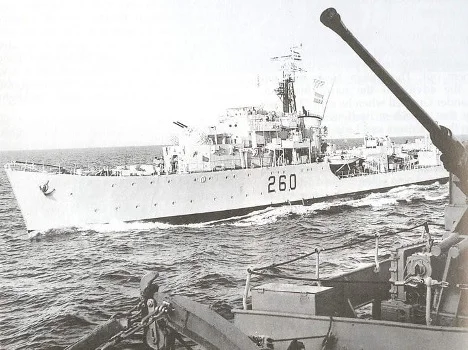On the night of 7 September 1965, as the Indo-Pakistani War raged across Punjab and Kashmir, the Pakistan Navy prepared for an audacious strike that would etch its name into history. Karachi had come under repeated threat from Indian bombers, guided by a radar station at Dwarka, Gujarat, some 200 kilometers from Pakistan’s coast. Protecting Karachi, the beating heart of Pakistan’s economy, became a matter of survival. It was here that the Navy under Commodore S. M. Anwar, Commander of the 25th Destroyer Squadron, a bold plan: strike Dwarka, silence its radar, and prove that the Arabian Sea belonged not to the larger Indian fleet, but to Pakistan’s daring sailors.
The Bold Execution of Operation Dwarka
The operation was codenamed “Somnath”, later remembered as Operation Dwarka. Its objectives were clear: destroy the radar station aiding Indian bombing missions, lure the mighty Indian fleet out of Bombay harbor, where PNS Ghaziwaited in ambush, and deliver a blow to Indian morale that would ripple across the battlefield. The mission was not only tactical but symbolic, a message that Pakistan’s Navy could reach deep into enemy waters with precision and courage.
That evening, a squadron of seven warships cut through the dark Arabian waters: the flagship PNS Babur, destroyers PNS Khaibar, PNS Badr, PNS Jahangir, PNS Alamgir, PNS Shah Jahan, and the frigate PNS Tippu Sultan. They were World War II–era vessels, but they carried with them the fighting spirit of a young nation determined to defend its honor. Their commander gave the order: close in on Dwarka, strike swiftly, and vanish before the enemy could even comprehend what had happened.
At exactly 00:24 hours on 8 September, the ships reached within 5.5 to 6.3 nautical miles of the coast. Suddenly, the silence of the Arabian night was shattered by thunder. Each ship opened fire, unleashing more than 50 high-explosive shells apiece. In just four minutes, nearly 350 rounds rained down on Dwarka. The radar station was struck, communication lines severed, a railway guest house hit, and industrial installations, including a cement factory, damaged. Flames lit up the skyline as Dwarka, a town the Indians thought untouchable, trembled under the storm of Pakistani guns.
The squadron advanced via position 239°, approximately 120 miles from Dwarka Lighthouse, maintaining strict radio silence and blackout conditions. The initial firing point was chosen six miles south of Dwarka lighthouse to maximize accuracy. Using 5-inch, 4.5-inch, and 4-inch naval guns, the warships fired their barrage and immediately disengaged. By 06:35 hours on 8 September, the task force had withdrawn safely and returned to patrol stations, completing the mission with flawless execution.
PNS Ghazi and the Silence of the Indian Fleet
While the surface fleet bombarded the shore, beneath the waves lurked the silent hunter: PNS Ghazi, South Asia’s only long-range submarine. Its mission was to sink any Indian ship that dared respond, with the aircraft carrier INS Vikrant as the prized target. Though Vikrant remained in refit, Ghazi’s unseen presence froze the Indian Navy in its harbors. The fleet that boasted of superiority dared not face Pakistan’s submariners.
The success of Operation Dwarka was measured not in buildings destroyed, but in the enemy’s humiliation. The Indian frigate INS Talwar, docked nearby at Okha, failed to intervene; whether from mechanical failure or fear, it never fired a shot. The Indian fleet stayed bottled up in Bombay. The Indian Air Force, deprived of radar guidance from Dwarka, reduced its raids on Karachi. And across India, questions echoed: how could a smaller navy strike so boldly, so close to India’s shore, and escape unscathed?

Indian officials later downplayed the damage; some even mockingly claimed that only a cow had been killed. Yet behind closed doors, the embarrassment was real. In the Indian Parliament, questions were raised about the Navy’s preparedness. The sting of Dwarka was so deep that it triggered India’s massive naval modernization program after the war, including the purchase of Soviet missile boats later used in 1971. Pakistan, meanwhile, celebrated the operation as a testament to ingenuity and bravery.
Legacy of Pride: Pakistan Navy Day
For Pakistan, Dwarka was more than a raid; it was a declaration. It showed the world that the Pakistan Navy, though smaller, could outthink and outfight a larger foe. It safeguarded Karachi, lifted the nation’s spirits, and forced India onto the defensive. Most importantly, it gave Pakistan a day of pride that is remembered every year as Pakistan Navy Day on 8 September, honoring the sailors who wrote this chapter of glory.
Operation Dwarka remains immortal in Pakistan’s history, a night when courage outshone numbers, when strategy overcame size, and when a young navy carved its place among the guardians of the seas. It was not just a strike against a radar, but a strike at the heart of Indian confidence. For Pakistan, it was nothing short of heroic success, a shining story of valor, unity, and victory against overwhelming odds.


